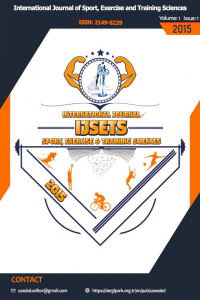Fonksiyonel denge antrenmaninin adölesan futbolcularin statik ve dinamik denge performanslari üzerine etkileri.
Denge yeteneği, Vuruş performansı; Dominant bacak; Dominant olmayan bacak; Top hızı;
Effects of functional balance training on static and dynamic balance performance of adolescent soccer players
___
- Anderson, K.G., Behm D.G. (2004). Maintenance of EMG activity and loss of force output with instability. The Journal of Strength & Conditioning Research, 18(3):637-640.
- Barfield, W.R. (1995). Effects of selected kinamatic and kinetic variables on instep kicking with dominant and nondominant limbs. Journal of Human Movement Studies, 29:251-272.
- Barfield, W.R., Kirkendall, D.T., Yu, B. (2002). Kinematic instep kicking differences between elite female and male soccer players. Journal of sports science & medicine, 1(3):72-79.
- Bieć, E., Kuczyński, M. (2010). Postural control in 13-year-old soccer players. European journal of applied physiology, 110(4):703-708.
- Bressel, E., Yonker, J.C., Kras, J., Heath, E.M. (2007). Comparison of static and dynamic balance in female collegiate soccer, basketball, and gymnastics athletes. Journal of athletic training, 42(1), 42-50.
- Cerrah, A.O., Gungor, E.O., Soylu, A.R., Ertan, H., Lees, A., Bayrak, C. (2011). Muscular activation patterns during the soccer in-step kick. Isokinetics and Exercise Science, 19(3):181-190.
- Davlin, C.D. (2004). Dynamic balance in high level athletes. Perceptual and motor skills, 1171-1176.
- Domholdt, E. (2000). Physical Therapy Research: Principles and Applications. WB Saunders Company, 277-279.
- Evangelos, B., Georgios, K., Konstantinos, A., Gissis, I., Papadopoulos, C., Aristomenis, S. (2012).Proprioception and balance training can improve amateur soccer players' technical skills. Journal of Physical Education and Sport, 12(1):81-89.
- Gerbino, P.G., Griffin, E.D., Zurakowski, D. (2007). Comparison of standing balance between female collegiate dancers and soccer players. Gait & posture, 26(4):501-507.
- Gioftsidou, A., Malliou, P., Pafis, G., Beneka, A., Godolias, G., Maganaris, C.N. (2006). The effects of soccer training and timing of balance training on balance ability. European journal of applied physiology, 96(6):659-664.
- Inoue, K., Nunome, H., Sterzing, T., Shinkai, H., Ikegami, Y. (2014). Dynamics of the support leg in soccer instep kicking. Journal of Sports Sciences, 32(11):1023-1032.
- Katis, A., Giannadakis, E., Kannas, T., Amiridis, I., Kellis, E., Lees, A. (2013). Mechanisms that influence accuracy of the soccer kick. Journal of Electromyography and Kinesiology, 23(1):125-131.
- Kibler, W.B., Press, J., Sciascia, A. (2006). The role of core stability in athletic function. Sports medicine, 36(3):189-198.
- Kornecki, S., Kebel, A., Siemieński, A. (2001). Muscular co-operation during joint stabilization, asreflected by EMG. European Journal of Applied Physiology, 84(5):453-461.
- Lees, A., Nolan, L. (1998). The biomechanics of soccer: a review. Journal of sports sciences, 16(3):211-234.
- Matsuda, S., Demura, S., Uchiyama, M. (2008). Centre of pressure sway characteristics during static one-legged stance of athletes from different sports. Journal of Sports Sciences, 26(7):775-779.
- Nolan, L., Grigorenko, A., Thorstensson, A. (2005). Balance control: sex and age differences in 9-to 16-year-olds. Developmental Medicine & Child Neurology, 47(07):449-454.
- Olivier, I., Palluel, E., Nougier, V. (2008). Effects of attentional focus on postural sway in children and adults. Experimental Brain Research, 185(2):341-345.
- Orchard, J., Seward, H. (2002). Epidemiology of injuries in the Australian Football League, seasons 1997–2000. British Journal of Sports Medicine, 36(1):39-44.
- Paillard, T., Noe, F., Riviere, T., Marion, V., Montoya, R., Dupui, P. (2006). Postural performance a strategy in the unipedal stance of soccer players at different levels of competition. Journal of Athletic Training, 41(2):172-181.
- Perrin, P., Deviterne, D., Hugel, F., Perrot, C. (2002). Judo, better than dance, develops sensorimotor adaptabilities involved in balance control. Gait & posture, 15(2):187-194.
- Prieske, O., Muehlbauer, T., Borde, R., Gube, M., Bruhn, S., Behm, D.G., Granacher, U. (2016). Neuromuscular and athletic performance following core strength training in elite youth soccer: Role of instability. Scandinavian Journal of Medicine & Science in Sports, 26(1):48-56.
- Putnam, C.A. (1993). Sequential motions of body segments in striking and throwing skills. Journal of Biomechanics, 26:125-135.
- Riach, C.L., Hayes, K.C. (1987). Maturation of postural sway in young children. Developmental Medicine & Child Neurology, 29(5):650-658.
- Ricotti, L. (2011). Static and dynamic balance in young athletes. J. Hum. Sport Exerc. 6(4):616-628.
- Romero-Franco, N., Martínez-López, E. J., Lomas-Vega, R., Hita-Contreras, F., Osuna-Pérez, M. C., & Martínez-Amat, A. (2013).
- Short-term Effects of Proprioceptive Training With Unstable Platform on Athletes' Stabilometry. The Journal of Strength & Conditioning Research, 27(8), 2189-2197.
- Tracey, S.Y., Anderson, D.I., Hamel, K.A., Gorelick, M.L., Wallace, S.A., Sidaway, B. (2012). Kicking performance in relation to balance ability over the support leg. Human movement science, 31(6):1615-1623.
- Vleeming, A., Pool-Goudzwaard, A.L., Stoeckart, R., Wingerden, J.P., Snijders, C.J. (1995). The Posterior layer of the thoracolumbar fascial its function in load transfer from spine to legs. Spine, 20(7):753-758.
- Vuillerme, N., Teasdale, N., & Nougier, V. (2001). The effect of expertise in gymnastics on proprioceptive sensory integration in human subjects. Neuroscience letters, 311(2), 73-76.
- Vuillerme, N., Nougier, V. (2004). Attentional demand for regulating postural sway: the effect of expertise in gymnastics. Brain Research Bulletin, 63(2):161-165.
- Weineck, J. (2004). Optimales Training: Leistungsphysiologische Trainingslehre unter besonderer Berücksichtigung des Kinder-und Jugendtrainings. Spitta Verlag GmbH & Co. KG.
- Winter, D. A., Patla, A. E., & Frank, J. S. (1990). Assessment of balance control in humans. Med Prog Technol, 16(1-2), 31-51.
- Yaggie, J. A., & Campbell, B. M. (2006). Effects of balance training on selected skills. The Journal of Strength & Conditioning Research, 20(2), 422-428.
- ISSN: 2149-8229
- Başlangıç: 2015
- Yayıncı: İbrahim ERDEMİR
Mücadele sporlarına ilişkin tutum ölçeği geliştirme çalışması
Fatma ÇELİK KAYAPINAR, Serhat TEMÜR, Fatih AKCAN, Meral TEMÜR
Basketbol oynayan çocukların akademik akademik başarılarının bazı değişkenler ile ilişkisi
Gençlik Hizmetleri ve Spor İl Müdürlüğü'nde görev yapan personelin sosyal görünüş kaygısı
Ömer Faruk YAZICI, Çağdaş CAZ, Hulusi Mehmet TUNÇKOL
Ali Onur CERRAH, İsmail BAYRAM, Günay YILDIZER, Olgun UĞURLU, Deniz ŞİMŞEK, Hayri ERTAN
